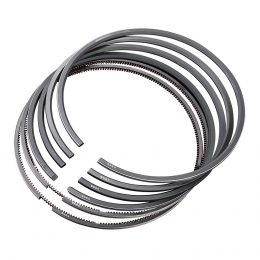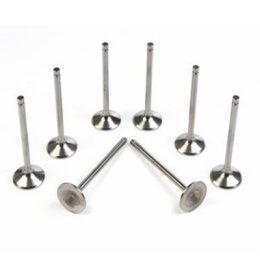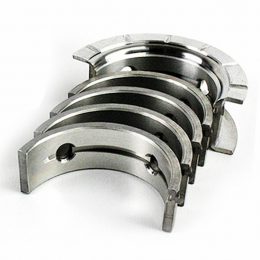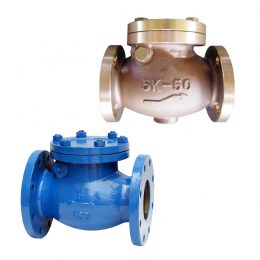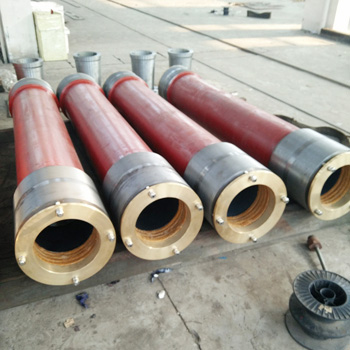
Rudder Stock
Rudder Stock Application
The rudder stock is also named the rudder shaft, which connects the steering gear with the rudder blade; the rudder stock transmits the steering gear’s turning force to the rudder blade to steer the ship. Usually, the rudder stock is made of forged steel. The rudder stock connects to the rudder blade by hydraulic cone fit or flange coupling; and connects to the tiller by hydraulic cone fit, a key connection, or by clamping rings for smaller rudders. Stainless steel sleeves are fitted in the way of bearings to protect the stock from getting damaged.
Rudder stock material
Historically stainless steel 316 has been the preferred rudder shaft material. This material was chosen as it was non-corrosive and strong and widely available. At the end of 20 century, alternative rudder stock materials like aluminum and high-strength stainless steel became more and more popular.
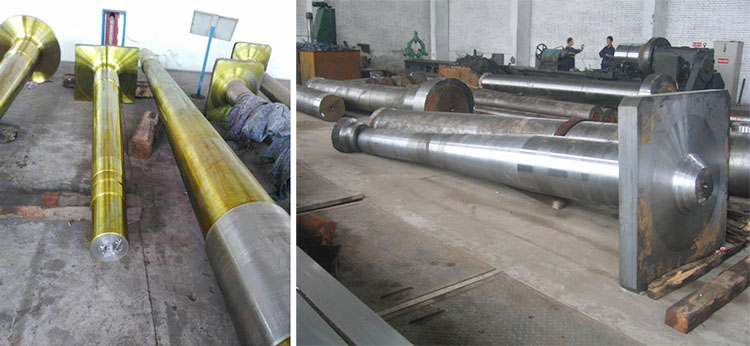
Driven by the aircraft and space industry, new high-quality aluminum alloys were developed. Some of these alloys turned out to be suitable for rudder shafts and other parts of sailing yachts. Gradually all big boat yards making GRP yachts converted to aluminum rudder shafts.
Important mechanical properties
To evaluate the mechanical properties of metals, one should first know that three mechanical properties of a metal are important for rudder stocks:
- 2% proof stress: As soon as forces are applied to a metal, it will deform. Up until the 0.2% proof stress, this deformation is called elastic deformation. This means that after the forces are taken away, the metal will come back to its original shape (with a maximum permanent deformation of 0.2%). The value of the 0.2% proof stress is given in Newton per square mm (N/mm²). Projected on a rudder shaft, this figure will determine the point of permanent damage. The rudder shaft will be bent and unusable when the forces on the rudder shaft will rise above the 0.2% proof stress.
- Tensile strength: The tensile strength or breaking strength determines the point where the stress level in the metal has risen so high that the metal is torn. The value of the tensile strength is given in Newton per square mm (N/mm²). For rudder stocks, this figure isn’t very important: From the proof stress point, the metal will flow and the rudder shaft will bend and break at the tensile strength point.
- Specific weight: The specific weight of metal is used to calculate the mass of a product with a given volume and is specified in Kg/m³. Very dense metals (like stainless steel) will have a high specific weight, and light metals (like aluminum) will have a low specific weight.
Characteristics of aluminum
The mechanical and anti-corrosion characteristics of aluminum depend on the alloy elements. Pure aluminum is not usable for a high-strength purpose like a rudder shaft. The most popular aluminum alloy for rudder shafts is AlMgSi1 (EN 6082). The magnesium element increases the mechanical properties, proof stress, and tensile strength. The silicon element increases the corrosion resistance of the aluminum. A hard and strong layer of silicon oxide SiO2 protects the aluminum even against the most hostile seawater. We use the following types of aluminum:
- Aluminum EN 6082 (AlMgSi1)
- The tensile strength is 340 N/mm2, the 0.2% proof stress is 280 N/mm2, and the specific weight is 2.700 Kg/m3.
- Aluminum EN 7075 (AlZnMgCu1,5)
- The tensile strength is 520 N/mm2, the 0.2% proof stress is 460 N/mm2, and the specific weight is 2.700 Kg/m3.
Characteristics of stainless steel
The mechanical and anti-corrosion characteristics of steel depend on the alloy elements and the heat treatment. By adding carbon, chrome, and nickel to iron and heat tread it correctly, one achieves the alloy stainless steel. The protection against corrosion is not achieved by an oxide layer like aluminum, but the added chrome and nickel make sure the metal itself will not oxidize. We use the following types of stainless steel:
- Stainless steel AISI 316 (1.4401)
- The tensile strength is 600 N/mm2, the 0.2% proof stress is 200 N/mm2, and the specific weight is 7.900 Kg/m3.
- Stainless steel AISI 329 (1.4460 or 1.4462)
- The tensile strength is 750 N/mm2, the 0.2% proof stress is 450 N/mm2, and the specific weight is 7.900 Kg/m3.
- Stainless steel AISI 630 (1.4418) (17-4PH)
- The tensile strength is 1.100 N/mm2, the 0.2% proof stress is 900 N/mm2, and the specific weight is 7.900 Kg/m3.
Comparing aluminum and stainless steel
Another important comparing factor, besides the mechanical properties, is the price of the rudder stock. To make a complete comparison between the four types of materials, we will take an example of the complete rudder stock. A typical rudder stock has its maximum diameter at the bottom bearing area, is tapered down to about 50% and up to about 60% of the maximum diameter, has a keyway, 3 or 4 spokes, and an emergency tiller connection.
Comparison between shaft materials
relative to aluminum AlMgSi1 (6082)
| Al. 6082 | Al. 7075 | St. St. 316 | St. St. 329 | St. St. 630 | |
| Proof Stress | 100% | 164% | 71% | 161% | 321% |
| Tensile Strength | 100% | 153% | 176% | 221% | 324% |
| Specific Weight | 100% | 100% | 293% | 293% | 293% |
| Relative Price | 100% | 200% | 250% | 300% | 300% |
Aluminum 6082:
Aluminum 6082 combines high proof stress with a relatively lightweight and low price. On top of that, it is fully seawater resistant. Due to these properties, 70-80% of the boat builders worldwide use this material as rudder stock material. The AL6082 rudder stocks can be anodized for extra protection. The downside of this material is the relatively thick rudder stock and therefore blade, so it is mainly used for cruising rudder blades.
Aluminum 7075:
On high-performance racing yachts with very thin-shaped rudder blades, one could use the high-strength aluminum 7075. The use of this material will allow minimizing the shaft diameter and thereby minimize the maximum rudder blade thickness. As this material is not seawater resistant, the complete rudder shaft will be anodized after production, making it completely electrically neutral, but a full proof guarantee on corrosion can not be given as any damage to the shaft will lead to corrosion. As these relatively thin rudder shafts will bend more than usual under loading, it is vital to use self-aligning bearings. It’s an ideal metal for boats that are not in the water all year long.
Stainless AISI 316:
When comparing aluminum 6082 and stainless 316, the first thing that catches one’s eye is the low proof stress of stainless 316. It’s the weakest material on the list. As a result of this, the rudder stocks made from this material will be thick and heavy and consequently expensive. The corrosion resistance is the best of all metals.
Stainless AISI 329:
When analyzing the figures for stainless 329, it’s obvious that this material is a much better choice over stainless 316. The price is only 10% higher than stainless 316 and the proof stress is 225% higher with the same corrosion resistance. Due to the high proof stress, one can make the rudder shaft thinner so the end price of the rudder shaft in stainless 329 is lower than the end price of the shaft in stainless 316. So one may conclude that when stainless steel is the preferred rudder material, and the thickness of the rudder blade is not an issue, one should use stainless 329.
Stainless AISI 630:
When the rudder blade thickness is an important issue and a carbon rudder shaft is not an option due to the much higher price, stainless steel 630 (also called 17-4 PH) is the best choice. It’s 4½ times as strong as stainless 316. It withstands corrosive attacks better than any of the standard hardenable stainless steel and the amount of corrosion is comparable to stainless 304. So in time, a brownish corrosion layer will cover the rudder stock and when submerged in seawater for a length of time, some small pitting may occur. This corrosion is harmless and doesn’t significantly influence the strength of the rudder stock. When this is undesirable, a thin (2½ mm) stainless 316 sleeves should be used around the rudder stock to achieve a corrosion-free running surface. See this web page. This metal is very popular in France, where thin rudder blades tend to be used and have been successfully used for over 25 years.
Conclusions:
- Aluminum 6082 rudder shafts are strong, light, and economic and ideal for cruising production yachts.
- If stainless steel is preferred, one should use stainless steel AISI 329.
- Stainless steel 316 rudder shafts are NOT stronger than aluminum 6082 rudder stocks.
- Very thin rudder blades can only use the ultra-strong stainless AISI 630 which has some small corrosion issues. (See the above text on how to avoid this).
- All measurements to avoid corrosion can be found on our electrolysis page.
